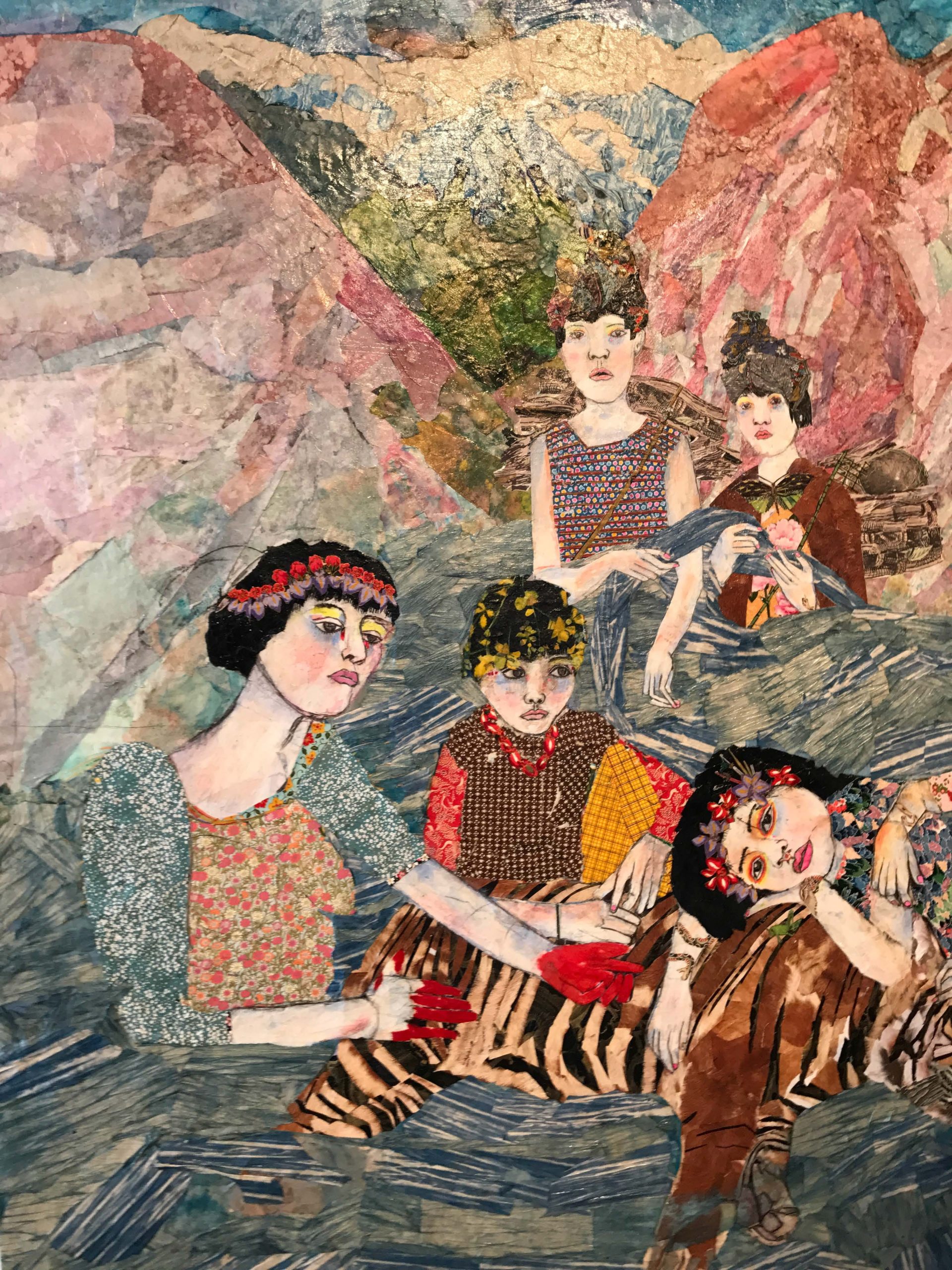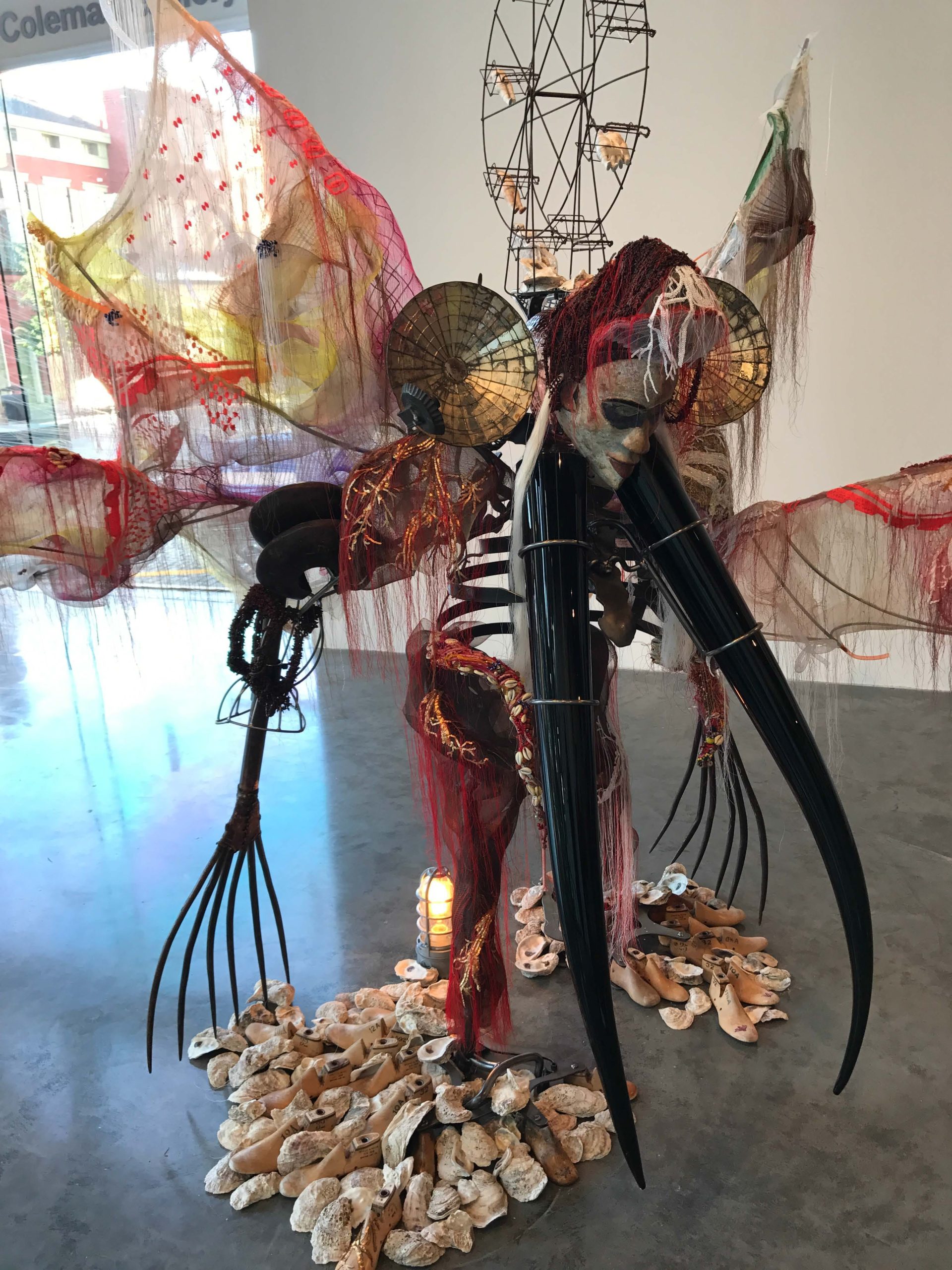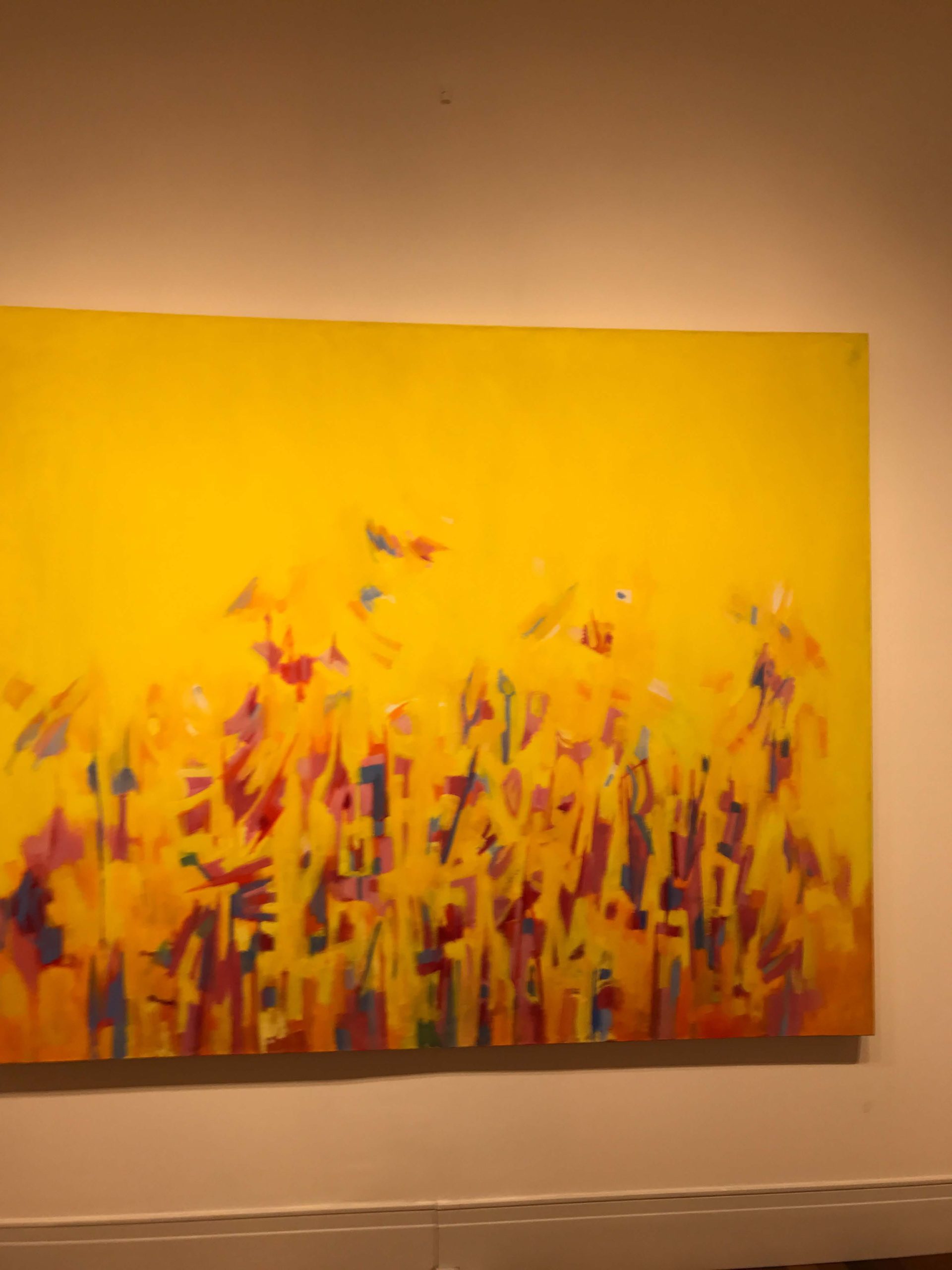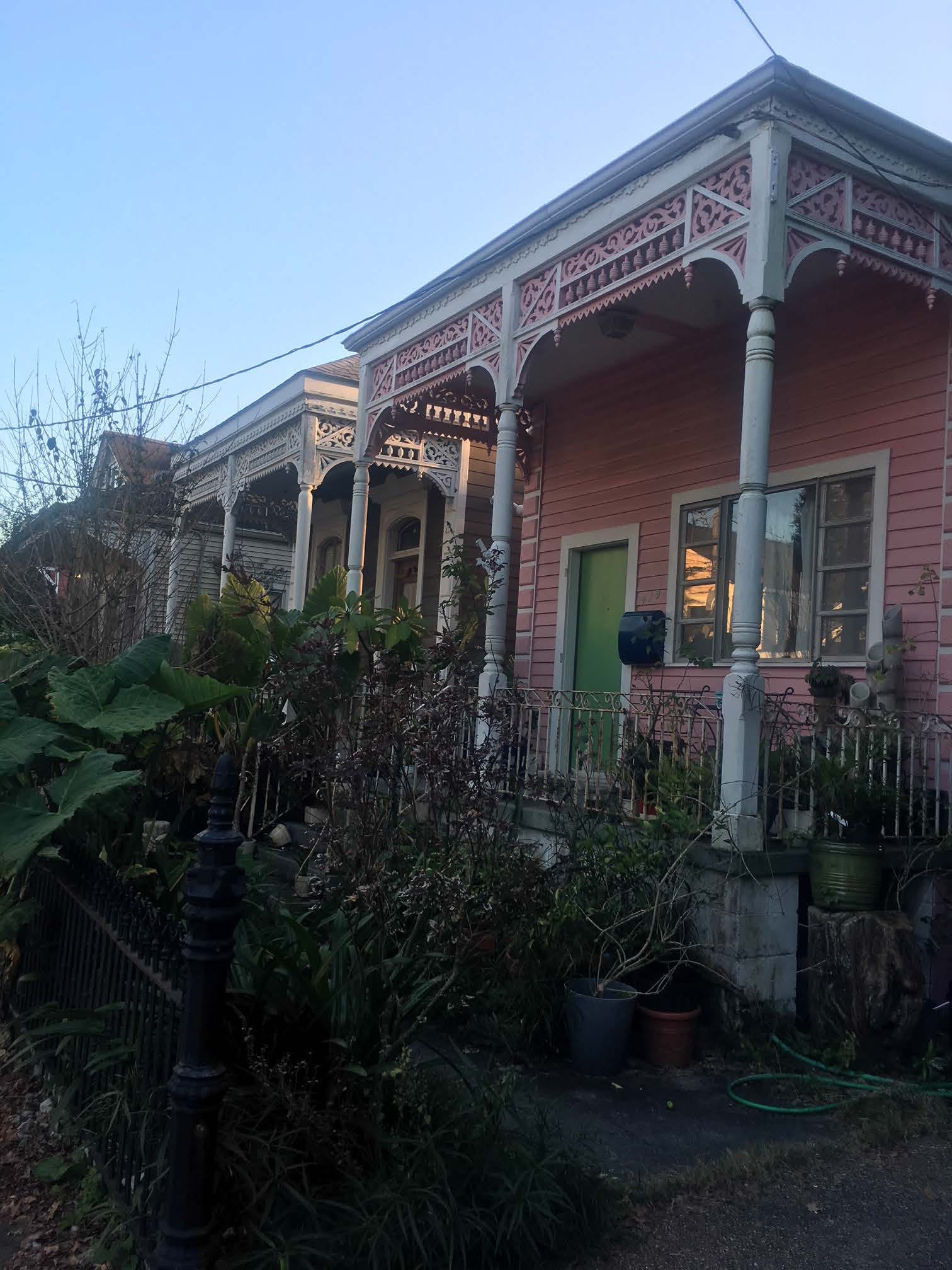Prospect 4: The Lotus in Light of the Swamp
By Barbara T. Hoffman
Fortunately, the stars aligned for me to attend the VIP/Press opening for Prospect 4, New Orleans’ citywide international contemporary art exhibit founded by curator Dan Cameron, former senior curator of the New Museum, in the wake of Hurricane Katrina in 2005. An intriguing mix of artists whose work I follow, invitations from friends, many from New Orleans or participating artists, and a litigation which settled, provided an irresistible opportunity for me to visit the fourth iteration of New Orleans’ citywide international contemporary art triennial, Prospect 4: The Lotus in Spite of the Swamp.
In contrast to its title derived from noted jazz saxophonist Archie Shepp’s description of jazz itself as “a triumph of the human spirit, a lily that grows in spite of the swamp”, Prospect 4’s use of the metaphor suggests a different kind of relationship: one where the emerging lotus has blossomed in interaction with its own environment instead of in opposition to it. In producing works in response to the current cultural, socioeconomic and environmental landscape, Prospect 4’s artists represent a form of symbiosis: they have grown in response to and in the context of, rather than outside of, their cultural and socioeconomic “ecologies”. As Artistic Director and Chief Curator of the Nasher Museum of Art at Duke University, Trevor Schoonmaker explains, ” The aquatic perennial takes root in the fetid but nutrient-rich mud of swamps so that its beautiful flower may rise above the murky water. The flower’s grace is inextricably connected to the noisome swamp, just as redemption exists in ruin and creativity in destruction. Viewed as a symbol of spiritual enlightenment in Buddhism and Hinduism, the lotus suggests the possibility of overcoming arduous challenges.”
Cultural synthesis and syncretism inform many of the central issues explored in Prospect 4. The rich diversity of New Orleans is rooted in a long history of human interactions including colonization, the transatlantic slave trade, waves of migration and displacement and Gulf Coast trade buoyed by the city’s position as the American South’s largest port. Many of the artists in Prospect 4 explore related themes, connecting them to contemporary geographies and cultures around the world. The unique and fragile ecosystem of New Orleans provides an alternative source of inspiration for some of the 73 artists from North America, Latin America, the Caribbean, Africa, Asia and the European powers that colonized New Orleans. The artists’ curatorial direction is “to address issues of identity, displacement and cultural hybridity within the context of the celebration of the city’s Tricentennial. Thirty two artists created work specifically for the exhibition, and approximately 10% of the selected artists hail from the New Orleans area.”
Venues include the New Orleans Museum of Art, the Ogden Museum of Southern Art, the Contemporary Arts Center, Historic New Orleans Collection, and the Jazz Museum at the Old US Mint, as well as interventions in unexpected destinations, such as Louis Armstrong Park (“Preservation Hall”) the recently developed Crescent Park along the Mississippi River, and Historic Algiers Point. (Unfortunately the inauguration of The Kataswof Karavan, Kara Walker’s first public commission since 2014 has been delayed until February.)
The press brochure states that “at the heart of Prospect is the connection that it enables between “high art” and the larger cultural landscape of the city, with its rich and diverse vernacular traditions of music, Mardi Gras Indians, second line parades, and other popular cultural forms. Prospect introduces audiences to the richness of New Orleans culture as seen through the eyes of artists.” Having had the opportunity to also attend and review the Venice Biennale, Documenta and Muenster, Prospect 4 certainly holds its own in terms of artistic quality and new discoveries. Like Venice, itself a product of cultural synthesis and global exchange through international trade, New Orleans’ magic is central to Prospect. “Its history of creolization and cross-cultural fertilization informs more than the evolution of jazz; it is central to the very essence of New Orleans, as is evidenced in the hybrid nature of the city’s customs and celebrations, food ways, religion, architecture, language, numerous genres of music and people themselves. In no other American city is this concept such a part of the everyday.”
The unique character and atmosphere of New Orleans, leaves its indelible mark on both the visitor and the artist. Not surprisingly, music and masques orchestrate our walking tour of the venues.
There is much to digest in this triennial. What follows is a very brief first impression based on a wonderful three days in New Orleans. This is my first Prospect and only second visit to New Orleans. While not disagreeing entirely with some recent critical reviews which opined that Prospect 4 was about big name artists and little risk taking, the images and brief commentary below explain why I recommend that Prospect 4 is well worth a visit, whether you are an art world nomad, a fair VIP and a collector, or you just want to experience a wonderful weekend get away of art, music, food and culture.
Contemporary Arts Center New Orleans
900 Camp St.
The Contemporary Arts Center is a venue which has a majority of the artists in Prospect. It’s a good starting point.
Throughout the exhibition are the amusing works of Taiyo Kimura, a series of sculptures depicting the artist curled up in a ball with his head between his knees on which security guards and visitors are encouraged to sit.

Barbara Hoffman sits atop Taiyo Kimura’s Untitled (Stool for Guard) (2007-2017).

Taiyo Kimura, Untitled (Stool for Guard) (2007-2017). Photo by author.

Alfredo Jaar, One Million Points of Light (2005). Lightbox with color transparency, 45 × 60 × 12 cm. Photo by author. (First floor, in the back.)
One Million Points of Light deals with the Atlantic Slave Trade which began in the 15th Century. The video captures sunlight reflecting off the ocean between Angola and Brazil. “It appears as if the light hitting the water becomes a layer that could be peeled back like skin, revealing the deep suffering to which the artist alludes.” The conceptual work is accompanied by a postcard at the entrance.

Edgar Cleijne and Ellen Gallagher, Highway Gothic, 2017. 16 mm film installation with 70 mm film cyanotype banners. Photo by author. (First floor in back.)

Maria Berrio, Syzygy, 2017. 80 x 96 inches. Collage w/ Japanese paper, watercolor and charcoal on canvas. Photo by author.
How did I miss knowing about this Brooklyn based artist from Colombia whose elegantly executed hallucinatory collages create beauty through the mixing of differences. The work easily fits within a tradition of both Indian miniatures and Japanese painting. In fact, Berrio physically reinforces her cross-cultural approach through her hybridized materials, the collages are fashioned from handmade papers produced almost entirely in Asia and South America; Nepal, India, Japan, Mexico and Brazil.

Rina Banerjee, “Viola from New Oleans-ah…”, 2017. Photo by author.

Zina Saro-Wiwa, Still from “Table Manners” series. Photo by author. (Second floor.)
Ogden Museum of Southern Art
925 Camp St.

John Akomfrah, Still from Precarity, 2017. Three channel HD color video installation, 7.1 sound. Dimensions variable. Photo by author.
Literally across the street from the CAC, is the Ogden Museum. The Museum is a venue for Prospect 4. If one has limited time, I would focus on seeing the amazing film of John Akomfrah. John Akomfrah is an important filmmaker who is of the generation of Isaac Julien and Steve McQueen. This mesmerizing film poetically examines the life of Charles “Buddy” Bolden, the first person known to have explored the music of jazz. Bolden ruled New Orleans with his coronet from 1900-1907 when he was permanently committed to the state insane asylum with schizophrenia. In an interview, Akomfrah said that his challenge in the film was to make a documentary about a mythical figure who left behind no known recordings and only a couple of grainy images. Precarity also explores New Orleans and the role of water, both in the City and in the Negro Spiritual. This film was a high point of my visit. It is an object with an energy of its own which creates an emotional empathy beyond intellect for its subject and its time, a hallmark to which art aspires but not often attains in this medium.
Solidary and Solitary: The Pamela J. Joyner and Alfred J. Giuffrida Collection
at the Ogden Museum of Southern Art
925 Camp St.

Leonardo Drew, 138L, 2015. Wood and paint. 110 3/5 × 111 4/5 × 40 1/5 in. Photo by author.

Detail of Leonardo Drew’s 138L, 2015. Photo by author.

Solidary and Solitary: The Joyner/Giuffrida Collection, Installation view. On the left are works by Melvin Edwards; on the right, Leonardo Drew, Number 52S, 2015. Photo by author.

Kevin Beasley, Bronx Fitted, 2015. New Era ® fitted Yankees caps, bandanas, resin, television mount; diameter 70 in, depth 16 in. Photo by author.

Detail of Shinique Smith’s No Key No Question, 2013. Ink, acrylic, fabric, and collage on canvas over panel; 60 x 60 x 2 in. Photo by author.

Norman Lewis, Afternoon, 1969. Oil on canvas; 72 x 88 in. Photo by author.

Charles Gaines, Numbers and Trees, Central Park, Series I, Tree #9, 2016. Black-and-white photograph, acrylic on plexiglass (3 panels); each 96 x 42 in. overall appox. 8 ft. x 10 ft. 6 in. Photo by author.
While Solidary and Solitary: The Joyner/Giuffrida Collection is not part of Prospect 4, it is an excellent historical parallel to Prospect which focuses almost exclusively on the narrative, identity and tradition by contemporary artists, many of whom are African American. By contrast, the Joyner/Giuffrida Collection honors solitude, the single mindedness necessary to refuse social categorization. Older artists of African descent are exhibited with younger artists influenced by their work. As the catalog states, “it turns away from the canon of masters moving relentlessly forward in single file and rejects a technocratic model of progress that ignores genuine social progress (or the lack thereof). This history also departs from a monolithic narrative of what it means to be black in order to receive ‘all fourteen channels’ of blackness that Bradford demands- to get down to what Ligon calls ‘the fine point’. In a section called Solos and Duets, the exhibition includes Norman Lewis, Sam Gilliam, and compares artists such as Melvin Edwards and Leonardo Drew and Kevin Beasley and Shinique Smith.” While this is only a fraction of the collection, I did notice the absence in the older artists of African descent, of any women artists who were working and are still working with abstraction, eg. Howardena Pindell with a pedigree including Boston University and an MA from Yale School of Art, 1965-1967. Few artists can lay claim to having influenced as many areas of art history as Howardena Pindell, whose 1970’s paintings are essential examples of postwar abstraction.
I was blown away by this exhibition. One is immediately struck by the power of the works and the absence of holding of this extent and quality in major museums. As Christopher Bedford, the co-curator of the exhibition and director of the Baltimore Museum of Art stated: “When I imagine the collection at the Baltimore Museum of Art in 10 to 20 years, I imagine an inclusive history, to integrate white Americans with black Americans and the contributions of Latinos, Asians, and others. We do a very poor job of that as a museum community. This exhibition shows everything that is missing.”
Both the narrative and abstraction by artists of African descent have in common the fact that they were devalued by exclusion from the discourse by white power structures.
The New Orleans Jazz Museum at the Old U.S. Mint
400 Esplanade Ave.

Hank Willis Thomas , History of the Conquest, 2017 . Bronze , 86′ x 118′ x 48′. Photo by author.


Mardi Gras Indian Costumes by Darryl Montana on display at the New Orleans Jazz Museum, 2017. Photo by author.
The Montana Family has been instrumental in carrying out the tradition of suiting, unique to New Orleans and the Mardi Gras tradition. “The black masking Indian tradition in New Orleans is rooted in remembering resistance to English/American monoculture.” “The richly beaded suits and feathered ritual paraphernalia of Mardi Gras Indian Darryl Montana, long-time Big Chief of the Yellow Pocahontas tribe, which rose to prominence as the “modernist” Mardi Gras Indian movement that stressed aesthetic excellence under the long reign of his father, legendary Big Chief Allison “Tootie” Montana. Originally inspired by the Native Americans who gave sanctuary to runaway slaves in antebellum Louisiana, Mardi Gras Indians need no introduction to most New Orleans residents, but their presence at the Mint reminds us that their traditional chants, such as “Iko Iko” or “Hey Pocky Way,” are inseparable from the musical feedstock that gave us jazz, rhythm and blues and, ultimately, rock music.”

Rashid Johnson, Fiend, 2017. Steel rebar, audio foam, microphone. Dimensions variable. Photo by author.
Louis Armstrong Park and Preservation Hall
701 N Rampart St., 726 St Peter St.

Derrick Adams, Saints March, 2017. Single Channel Video with sound. 4 Minutes. Photo by author.
The multimedia work, inspired by the street tappers often found in the French Quarter, is typical of Adams’ multilayered aesthetic vision, which mixes formalism with social and political commentary and includes layered representations based on place and identity. The work combines video footage of Torrance and Derrick Jenkins, cousins that Adams met while they were performing on North Peters St. The work includes a slow and soulful acapella rendition of Louis Armstrong’s seminal jazz song “When the Saints Go Marching In” (1938) performed by artist and singer/songwriter COR.ECE. Saints March incorporates sound and visuals to reaffirm the presence of the street tappers who are “in tune with the rhythm of the street.” By placing the work in Perseverance Hall and the Riverside Line streetcar, Adams carries the ethos of these young performers throughout the city.
Go into the park and walk right over the bridge to the small building Preservation Hall. There is also a street festival on Saturdays.
New Orleans Museum of Art
1 Collins Diboll Cir.

Dawit L. Petros, Untitled from The Stranger’s Notebook (Prologue) series, 2016. Archival color pigment print.

Dawit L. Petros, The Act of Recovery (Part 1), Nouakchott, Mauritania, 2016, archival color pigment print.
As the catalog states, “fully aware of the narrative limitations of the still image, Petros instead creates photographs that operate as metaphors. The people in his photographs obscure their faces with mirrors or empty boxes, replacing the very thing most closely associated with identification and documentation with a reflective surface or a void…the image intentionally challenges the idea of photography as a passive source of information and forces the viewer to consider a history outside the frame in both a literal and a conceptual sense.”
Petros, who was born and spent his childhood in Eritrea, is continuing work on his immigration/refugee series in southern Italy.

>
Njideka Akunyili Crosby, I See You In My Eyes, 2015. Acrylic, oil, transfers, colored pencil and collage and commemorative fabric on paper. Photo by author.

Njideka Akunyili Crosby, I Still Face You, 2015. Acrylic, oil, transfers, colored pencil and collage and commemorative fabric on paper. Photo by author.
“The meticulously detailed scenes evince her profound engagement with traditional Igbo visual and material culture as well as that of her adult life in the United States (she now lives and works in Los Angeles, after moving to Pennsylvania as a teenager.)”
Njideka Akunyili Crosby is another, oh my god, how did I miss knowing this artist. Immediately attracted to the skill of her craftsmanship and the layers of subject matter and material she references, Crosby was another exciting discovery. I was not surprised to learn that she was awarded a 2017 McArthur genius grant, only that I discovered here in Prospect. Oh, well my only excuse is she is LA based.

Barkley Hendricks, The Way You Look Tonight/Diagonal Graciousness, 1981. Photo by author.
In this work, note the surrealist reference to Magritte. This nod of his hat to surrealism is similar to the reference in Akomfrah’s Precarity, in which Akomfrah acknowledged his debt to surrealism in the making of the film.
“The influence of Hendricks’s art is profound, flowing into the work of artists like Lynette Yiadom-Boakye, Whitfield Lovell, Kehinde Wiley, and many, many more. Looking historically, his close eye for the detail of vernacular life connects him with both the Pop and Photo Realist movements, though his focused approach evades a firm identification with either category. Asked about his own influences in a 2009 interview with the Smithsonian, he cited Old Masters like Velazquez, Caravaggio, Rembrandt, and Vermeer.”( Art News,)
Like August Sander, Richard Avedon, Philip Pearlstein, Sylvia Sleigh, Archibald Motley, and Kerry James Marshall, he carefully, indefatigably, and with great élan documented the world around him, assembling a body of work that now defines an age.” http://www.artnews.com/2017/04/18/barkley-l-hendricks-whose-tender-and-immaculate-portraits-define-an-age-dies-at-72/
The Great Hall of the New Orleans Museum of Art features a large installation of twelve of Hendricks’ portraits that functions as an informal tribute to the late artist. The oil paintings included in the exhibition range from 1970-2016. While Hendricks has recently been recognized as a giant of American painting, it is astounding that Schoonmaker’s 2008 exhibition was Hendricks’ first career retrospective, and this is the first time his works have been exhibited in New Orleans.
This museum also exhibits works by Alexis Esquivel, Xaviera Simmons, Gauri Gill and Rajesh Vangad, also not previously on my radar and whose work I was delighted to encounter.
Historic Algiers Point
101-199 Mississippi River Tr.

Mark Dion, The Field Station of the Melancholy Marine Biologist, 2017. Mixed media. Dimensions variable. Photo by Florence Lynch.

Above, a home located at Historic Algiers Point: New Orleans’ second oldest neighborhood, founded in 1719. It was the site of the pens that held enslaved Africans before they were sold into slavery at the French Quarter. Photo by Florence Lynch.
My friend Florence and I made the trip to Algiers Point and through some error of miscommunication took a taxi to the ferry rather than the ferry to Algiers point. The historic community is worth the visit, but the ferry from Canal Street to Algiers Point is the way to go ($1.25 versus $19.00). If one is short on time, this can be eliminated.
Crescent Park
1008 N. Peters St.

Jennifer Odem, Rising Tables, 2017. Antique tables and steel. Dimension vary. Photo by author.
The Crescent Park, which features the works of four artists, is a lovely place to walk. Though I missed Radcliffe Bailey’s Vessel and Hong-An Truong’s To Speak A Language as they were surprisingly difficult to locate, I immensely enjoyed the picturesque view of Jennifer Odem’s Rising Tables, pictured above. I recommend stopping by the restaurant Elizabeth’s at 601 Gallier St for some down home New Orleans country classics.
Music, jazz, Creole culture, the French Quarter, architecture and Louisiana’s 300-year history make this a destination for art unlike any other. I would recommend for convenience the Ace Hotel, which itself is home to one installation by Louisiana artist Genevieve Gaignard. There are also iconic films by Horace Ové, Zak Ové and others which are well worth seeing.
Finally, there is no shortage of excellent restaurants in New Orleans. My favorite for food and character is Upperline at 1413 Upperline St. I recommend the New Orleans local special menu of seven courses which, to keep you from appearing more piggish than your companions who have ordered the three course menu, is served with three courses – three courses – one course. Pesche is also a convenient spot for lunch in New Orleans, located at 800 Magazine St.


